Blansko, South Moravian Region, Czech Republic
🇨🇿 Blansko is a town in the South Moravian Region of the Czech Republic. It lies on the Svitava River on the border of the Moravian Karst. It is mainly an industrial town.
Administrative parts Villages of Češkovice, Dolní Lhota, Horní Lhota, Hořice, Klepačov, Lažánky, Obůrka, Olešná, Skalní mlýn, Těchov and Žižlavice are administrative parts of Blansko.
Geography Blansko is located about 16 km (10 mi) north of Brno. It lies in the Drahany Highlands. The highest point is the hill Bukovec with an altitude of 596 metres (1,955 ft). It is situated in the valley of the river Svitava, the majority of the town is situated on a slope above the left bank of the Svitava. The eastern part of the municipal territory lies in the Moravian Karst Protected Landscape Area.
History Blansko was originally founded as a settlement on the right bank of the Svitava, today the local part called Staré Blansko ("Old Blansko"). It was located on an important trade route from Bohemia to the regions around Danube. The first written mention of Blansko is from 1136. It was the site of dispute between Jindřich Zdík, the bishop of Olomouc, and Prince Wratislaus of Brno regarding the rights to construct a church in the village.
From the end of the 14th century, a new settlement began to grow on the left bank, known as Nové Blansko ("New Blansko"), which later became the core of the modern town. Both parts developed administratively and economically independently until 1526, when they merged. In the late 16th century during the rule of the Žalkovský of Žalkovice family, Blansko was promoted to a market town. The family had rebuild the local Gothic fortress into a Renaissance residence.
From 1698 the Gellhorn family owned the estate and founded here the first foundry and ironworks. In 1766, Blansko was bought by the Salm-Reifferscheidt family. They owned it until 1945. In the first half of the 19th century, the ironworks prospered and developed and the expansion of the production of artistic cast iron occurred. In 1849, the railway from Brno to Česká Třebová was opened. In 1905, Franz Joseph I of Austria granted Blansko the status of the town.
In 1949, Blansko became the capital of Blansko District instead of Boskovice. From the 1960s to the 1980s, the town became the centre of the engineering industry and the population grew rapidly. As a result of new construction, most of the historic buildings disappeared.
Economy The largest industrial employers based in the town are Pyrotek CZ (aluminum processor), ČKD Blansko (manufacturing of hydro machines, heavy-duty machining tools and mechanical engineering metallurgy, founded in 1950), and a branch of Synthon (producer of generic drugs).
The longest tradition has the still operating company Metra Blansko, manufacturer of electric measurement devices, which was founded in 1911.
Sport The town's football club is FK Blansko. The club participated in the 2020–21 season of the Czech National Football League, but was immediately relegated.
Sights The main sight is the Blansko Castle. The Renaissance castle was built in 1604–1605 by reconstruction of a Gothic fortress from the 14th century. Today it houses the Blansko Region Museum with exhibitions of Moravian Karst and its exploration, the tradition of the iron industry in Blansko and the production of artistic castings.
The Church of Saint Martin was built in 1672–1691. It replaced an original Romanesque and later Gothic church from the 12th century. In 1707–1708, the church was reconstructed and a new tower was added. The tower is open to the public and serves as a lookout tower. The church has one of the oldest bell still extant in Moravia.
The wooden Church of Saint Paraskieva was built in Carpathian Ruthenia in 1601–1641 and brought to Blansko in 1936. It is the oldest church of the Ruthenian Gothic type in the country.
The Klamovka Ironworks is the last preserved foundry and ironworks from the 1850s. It is a typical example of the industrial architecture of the mid-19th century.
The town hall from 1885 replaced an old wooden structure with a tower which originated from the 16th century. In 1904, the clock tower was completed.
Lednice, South Moravian Region, Czech Republic

Blansko has a population of over 20,000 people. Blansko also forms the centre of the wider Blansko District which has a population of over 108,801 people.
To set up a UBI Lab for Blansko see: https://www.ubilabnetwork.org Twitter: https://twitter.com/UBILabNetwork
Twin Towns, Sister Cities Blansko has links with:
🇷🇺 Borisoglebsk, Russia 🇸🇰 Komárno, Slovak Republic 🇵🇱 Legnica, Poland 🇦🇹 Mürzzuschlag, Austria 🇮🇹 Scandiano, Italy🇩🇪 Heidelberg 49.414
🇺🇦 Khmelnytskyi 49.417
🇫🇷 Thionville 49.359
🇩🇪 Neustadt an der Weinstraße 49.351
🇩🇪 Neunkirchen 49.344
🇨🇦 North Vancouver 49.321
🇩🇪 Schwandorf 49.317
Locations Near: Blansko 16.6448,49.3632
🇨🇿 Kuřim 16.517,49.283 d: 12.9
🇨🇿 Svitavy 16.467,49.75 d: 44.9
🇨🇿 Prostějov 17.1,49.467 d: 34.9
🇨🇿 Olomouc 17.252,49.595 d: 50.9
🇨🇿 Břeclav 16.867,48.75 d: 70.1
🇨🇿 Šumperk 16.976,49.965 d: 71.1
🇨🇿 Hodonín 17.129,48.852 d: 66.8
🇨🇿 Žďár nad Sázavou 15.933,49.55 d: 55.5
Antipodal to: Blansko -163.355,-49.363
🇹🇴 Nuku'alofa -175.216,-21.136 d: 16705.9
🇵🇫 Papeete -149.566,-17.537 d: 16265.6
🇦🇸 Pago Pago -170.701,-14.279 d: 16056.9
🇼🇸 Apia -171.76,-13.833 d: 15990.4
🇺🇸 Hilo -155.089,19.725 d: 12289.4
🇺🇸 Maui -156.446,20.72 d: 12192.2
🇺🇸 Maui County -156.617,20.868 d: 12177.3
🇺🇸 Wailuku -156.505,20.894 d: 12173.5